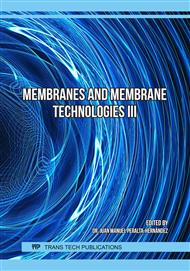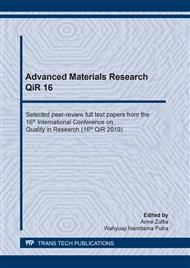p.257
p.265
p.272
p.278
p.285
p.293
p.303
p.311
p.318
Performance of Mesoporous Organo Silica Membrane for Desalination
Abstract:
Clean water is essential source for household purpose. However, many surface water contain high salt concentration was found. In this work, membrane was made using tetraethyl orthosilicate (TEOS) as silica precursors and citric acid as single organo catalyst. Membranes were calcined at 200 and 250 °C using Rapid thermal processing (RTP). All membranes were tested via pervaporation. Pervaporation processes allow membrane to separate salt from water as vapour phase with vacuum condition required. Permeate was collected in the cold trap after condenses. This study focus to the performance of organo silica membrane in variance of refluxed 0 and 50 °C and feed concentrations (0.3, 3.5 and 5wt% NaCl) at room temperature (~25 °C). Optimum condition was obtained at reflux 50 °C with high siloxane and Si-C bonds. Carbon content from citric acid promote silica network more strength. The good performances in variance feed concentration were also showed at reflux 50°C with 0.3324 kg.m-2.h-1 (0.3 wt%), 0,2290 kg.m-2.h-1 (3.5 wt%) and 0.2168 kg.m-2.h-1 (5 wt%). These membranes are categorized as mesoporous and achieve excellent salt rejection >95%.
Info:
Periodical:
Pages:
285-292
Citation:
Online since:
July 2020
Keywords:
Price:
Сopyright:
© 2020 Trans Tech Publications Ltd. All Rights Reserved
Share:
Citation:




